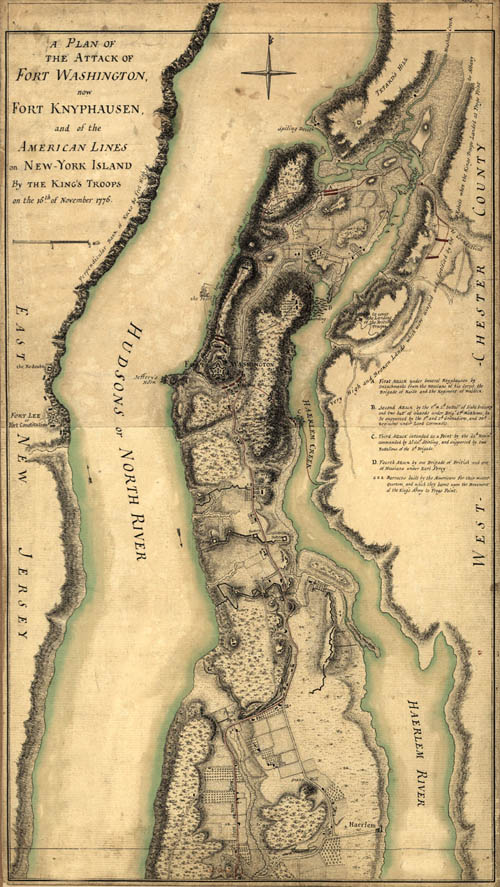Battle for Fort Washington
|
|
This Site:
|
Early on the morning of the 16th Howe opened a severe cannonade from the heights on the Westchester shore. Under its cover the attack was made in four columns. Knyphausen, with his Germans, moved up from the flats along the rough hills nearest the Hudson. At the same time Lord Percy led a division of English and German troops to attack the lines on the south. General Mathews, supported by Lord Cornwallis, crossed the Harlem near King's Bridge, with guards, light infantry, and grenadiers; while Colonel Sterling, with Highlanders, crossed at a point a little above the present High Bridge. The outworks of the fort were defended on the north by Colonel Rawlings, with Maryland riflemen and militia from Mercer's Flying Camp, under Colonel Baxter. The lines towards New York were defended by Pennsylvanians, commanded by Colonel Lambert Cadwalader. Magaw commanded in the fort Rawlings and Baxter occupied redoubts on heavily wooded hills. By a simultaneous attack at all points, the battle was very severe outside of the fort. The British and German assailants pressed hard upon the fort, and both Howe and Knyphausen made a peremptory demand for its surrender. Resistance to pike, ball, and bayonet, wielded by 5,000 veterans, was in vain, and Magaw yielded. At half-past one o'clock (November 17) the British flag waved in triumph over Fort Washington. The Americans lost in killed and wounded not more than 100 men, while the British lost almost 1,000. The garrison that surrendered, with militia, numbered about 2,500, of whom more than 2,000 were disciplined regulars. Washington, standing on the brow of the palisades at Fort Lee, saw the surrender. The name of the fortification was changed to Fort Knyphausen. Its garrison soon filled the prisons on land and water at New York. Recent discoveries show, that the fall of Fort Washington was accomplished through the agency of treason. See Edward F. Delancey's paper on Fort Washington, read before and published by the New York Historical Society in 1878. |
|
|
||
|
|
Site Copyright 2003-2018 Son of the South. For Questions or comments about this collection, contact: paul@sonofthesouth.net |
|
|
Are you Scared and Confused? Read My Snake Story, a story of hope and encouragement, to help you face your fears. |
||
